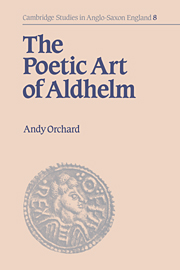Book contents
- Frontmatter
- Contents
- List of tables
- Preface
- List of short titles and abbreviations
- Sigla of scholars cited
- 1 Aldhelm's life and verse
- 2 Aldhelm and the Anglo-Latin octosyllable
- 3 Aldhelm's hexameter verse style and its origins
- 4 Aldhelm's remembered reading in verse
- Appendix 4.1 Parallel diction in Aldhelm's sources
- 5 After Aldhelm: the Anglo-Latin legacy
- Appendix 5.1 Parallel diction in Aldhelm's Anglo-Latin heirs
- Appendix 5.2 A statistical survey of Anglo-Latin verse
- Bibliography
- Index
3 - Aldhelm's hexameter verse style and its origins
Published online by Cambridge University Press: 23 November 2009
- Frontmatter
- Contents
- List of tables
- Preface
- List of short titles and abbreviations
- Sigla of scholars cited
- 1 Aldhelm's life and verse
- 2 Aldhelm and the Anglo-Latin octosyllable
- 3 Aldhelm's hexameter verse style and its origins
- 4 Aldhelm's remembered reading in verse
- Appendix 4.1 Parallel diction in Aldhelm's sources
- 5 After Aldhelm: the Anglo-Latin legacy
- Appendix 5.1 Parallel diction in Aldhelm's Anglo-Latin heirs
- Appendix 5.2 A statistical survey of Anglo-Latin verse
- Bibliography
- Index
Summary
There already exist several studies of various aspects of Aldhelm's hexameter verse composition. But the question of the ultimate models for Aldhelm's highly idiosyncratic manner of verse-composition has been rarely, or only tentatively, addressed. The possibility of vernacular poetic influence is occasionally raised, but the evidence presented so far is ambiguous or unclear. Even the matter of Aldhelm's Latin poetic sources requires fresh attention, since the question of what constitutes common non-classical usage is still unsettled. In addressing in turn such issues as prosody, elision, hiatus, metrics, line-structure and use of repeated metrical formulae, it will be helpful in each case to seek Latin models from those poets that Aldhelm can be shown to have read; only where there are no clear parallels amongst such authors will we be compelled to look elsewhere, to other Latin texts and even, ultimately, to vernacular sources. The breadth of reference is therefore necessarily great; the clearest result of the following study is to confirm just how remarkable Aldhelm was in his Latin hexameter verse style: there never was another like him.
The rules and theory of Latin prosody must have constituted the single most important obstacle to any Anglo-Saxon (indeed any non-native Latin speaker) attempting to compose metrical Latin verse. Strecker gives a lengthy (and by no means complete) list of anomalies in Aldhelm's prosody in his appendix to Ehwald's edition. Aldhelm's concern to transmit what he considered correct prosody to his peers is reflected in his De pedum regulis, where he compiles what is, in effect, ‘the first metrical gradus composed for non-Latin speakers’.
- Type
- Chapter
- Information
- The Poetic Art of Aldhelm , pp. 73 - 125Publisher: Cambridge University PressPrint publication year: 1994



